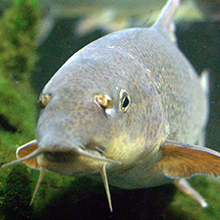‘Hypervirulent’ disease a burden on aquaculture
28 February 2019

Researchers have been using a combination of probiotics and vaccines to try and reduce the spread of a deadly fish disease.
Researchers believe that a ‘hypervirulent’ strain of Aeromonas hydrophila emerged in the US in 1989. This hypervirulent strain has a significantly higher mortality rate, killing as many as 50% of fish in a single outbreak.
A. hydrophila is a bacterial pathogen that infects warm water fish species, such as bass, catfish and pike. The disease is not usually fatal, but can cause death in ill or stressed fish. Symptoms usually include ulcers and tail rot, which can affect the growth of fish and negatively impact their welfare.
Hypervirulent Aeromonas hydrophila (vAh) originated in Asian carp, but researchers are concerned that the disease, which can infect several types of fish and passes between species, has spread to multiple countries. vAh causes more severe disease, including haemorrhagic septicaemia and is believed to be responsible for the loss of over 10 million kilograms of American catfish over the past ten years.
According to Professor Mark Liles of Auburn University, vAh is the most important disease in the US aquaculture industry. The disease also causes serious problems in Mexico, Cambodia and Singapore. He said, “It affects the lives and livelihoods of people in the aquaculture industry in multiple countries. We think this is likely a pandemic of disease that has yet to be fully documented.”
Currently A. hydrophila outbreaks in farmed fish are controlled using antibiotics, but as the issue of antimicrobial resistance looms, farmers are encouraged to move away from antimicrobials. Professor Liles has been developing two alternative strategies to control and prevent severe epidemics of vAh.
One strategy, which involves adding Bacillus species bacteria to fish food, has been found to reduce mortality by as much as 57%. The Bacillus in the feed act as a probiotic and protect fish against multiple bacterial diseases. It does this through a number of mechanisms, including producing an antibiotic called difficidin and by competing with pathogenic bacteria for nutrients. Professor Liles believes that due to the probiotic effect of Bacillus-supplemented feed, vAh is less likely to develop resistance as it does when purified antimicrobials are added to food.
In addition to reducing vAh mortality from 60% to 3%, the feed also improved fish growth by over 32%. Professor Liles said that the probiotic-supplemented feed affected the water quality, reducing phosphorus and nitrogen levels. This could prevent eutrophication—which often leads to other issues such as algal blooms which reduce the oxygen concentration in water and stunt fish growth—showing potential to improve the sustainability of aquaculture.
Another strategy trialled by Professor Liles is vaccination. His research team produced a vaccine against A. hydrophila using a genetic mutant. The vaccine was found to be effective and is administered to the fish either by immersion or orally. They found this to produce an immune response and protect catfish from vAh.
The results so far have been promising, Professor Liles said: “We are enthusiastic about our ability to control this pathogen through multiple technologies, including a probiotic and a vaccine, that can be used as part of sustainable aquaculture practices.”
Professor Liles is now in the process of forming a number of international collaborations to conduct a global survey of vAh. He hopes to establish an active network of scientists engaging in vAh research to collaborate to better understand the disease and its epidemiology, and consider ways to reduce antibiotic use and improve the health of fish in the aquaculture industry.
Professor Liles will present his data at the Microbiology Society Annual Conference in Belfast. His talk: ‘The global spread, pathogenesis and control measures for a hypervirulent Aeromonas hydrophila pathotype in warm water fish species’ will take place at 10:00 on Tuesday 9 April as part of the Non-human pathogens session.Image: Harri Haataja/Flickr.


